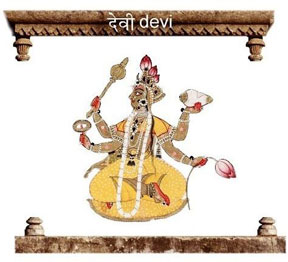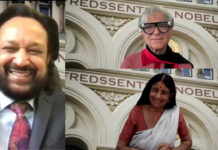
WASHINGTON DC: Smithsonian, the world’s largest museum and research complex headquartered in Washington DC, is showing an online exhibition titled “Devi: The Great Goddess”.
Displayed by its Freer Gallery of Art, this exhibition talks about various aspects of Devi, manifestations of Devi, cosmic force, creation, woman saints, etc. It depicts images of Bhadrakali, Lakshmi, Parvati, Markama, Durga, Chamunda, Kali, Sarasvati, Ganga, Vasudhara, Ambika, Radha, Sita, Mariamman, Varahi, Saint Karaikkal Ammaiyar, Saint Andal, etc.
Between 1660-1670, an unknown master in the Punjab hills of northern India painted a magnificent series of some seventy paintings which visualize Devi in expressive forms of strength and beauty. Only thirty-two of the original group have survived, of which six, with their accompanying verse, are exhibited here.
This series is known as the Tantric Devi series because the imagery suggests an affiliation with esoteric rites of Tantric worship. The paintings are embellished with voluptuous decorative details and the highly burnished surfaces incorporate a lavish display of applied beetle-wing cases in an intense green to simulate emeralds.
In Tantric art Devi appears in varying body configurations and has many skin colors, facial expressions and symbolic gestures. She may have two, four, or as many as ten arms, and wear a profusion of costumes and ornaments. She may stand with attending figures who express her reflected power, or stand or sit alone. She may be benign and nurturing or a furious protector. The spectrum of images makes the point: while the Goddess is one, she is worshiped as many.
In worshiping the goddess it is possible to arouse the divine power, Shakti, that lies dormant within individuals in order to make their physical, mental, and psychic selves divine. One method of worship aimed at integrating the physical and spiritual realms is Tantric worship which has characterized much of goddess worship in India. Tantra is a code of rites and practices
Commending Smithsonian for Devi exhibition, Rajan Zed, president of Universal Society of Hinduism, said that Hindu art had a long and rich tradition in Hinduism and ancient Sanskrit literature talked about religious paintings of deities on wood or cloth.
He urged major art museums of the world, including Musee du Louvre and Musee d’Orsay of Paris, Metropolitan Museum of Art in New York, Los Angeles Getty Center, to frequently organize Hindu art focused exhibitions, thus sharing the rich Hindu art heritage with the rest of the world.
Founded in 1846, the Smithsonian consists of 19 museums and galleries, the National Zoological Park, and nine research facilities. It has nearly 138 million collections and gets over 28 million visitors (besides over 175 million online visitors) annually. Dr. David J. Skorton is the Secretary.
Neela Pandya






